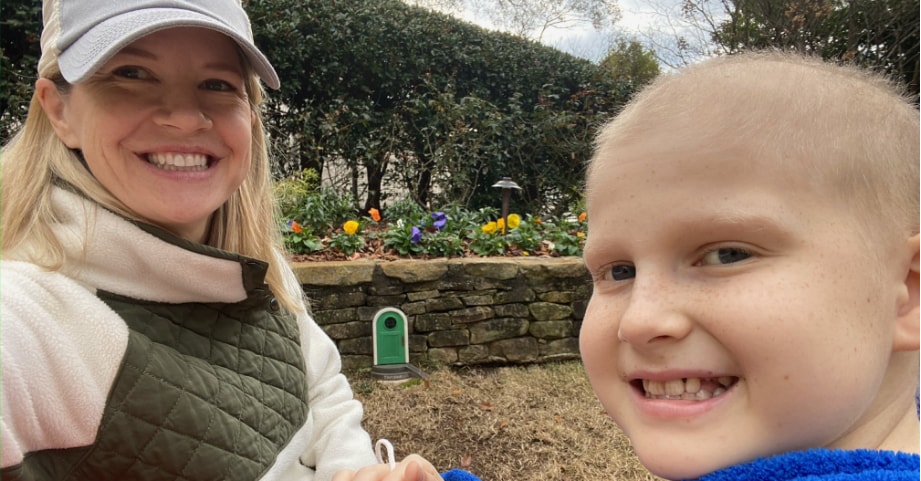10 Creative Ways to Help a Family with a Serious Diagnosis
Lex Stolle had just started the fifth grade when he was diagnosed with leukemia. He and his mom, Ashley, who’s also a pediatrician, share insight into the big and little ways their community rallied to power them from diagnosis to remission.

If you know someone whose family is facing a tough diagnosis, asking how you can help feels like a natural place to start. Sometimes, admitting to needing help can be difficult—or even feel like another chore or decision—for a family that is already overwhelmed. Instead of asking how you can help, here are some things you can do that can make a world of difference.
1. “I’m at the grocery store. What can I bring you?”
Lex’s mom, Ashley, valued receiving texts from friends who would share that they were already at a store and offer to pick up items while there. The casual nature of the gesture made it easy to accept, and she didn’t feel guilty about someone going out of their way to run an extra errand.
2. Hop aboard the meal train.
Families often say meal deliveries and gift cards are the most helpful and valued gifts. For those with chronic disease or long medical journeys, keep in mind it’s a marathon and not a sprint. Establishing a cadence of three to four deliveries a week over a longer time period, versus every day for a shorter time period, helps keep the momentum going.
3. Don’t forget siblings.
A patient’s siblings are on the journey, too. Help boost their spirits by inviting them to events and activities around town, or by including goodies especially for them in care packages. For those with younger children, volunteering to provide childcare during appointments or hospital stays can ease stress—emotionally and financially.
4. Show love to family pets.
From walks to overnight care to bathing duties, showing extra love to affected pets can be a meaningful way to provide support to a family. Helping to keep the pet clean or groomed goes a long way when hygiene is of utmost priority.
5. Be a green-thumbed angel.
As a family’s focus shifts to the health of their child, household chores naturally take a backseat. Depending on the season, anonymously raking a yard for leaves, helping pull weeds, or tending to potted plants can give a reprieve to a mounting household to-do list. You might even offer to foster a high-maintenance house plant (we’re looking at you, fiddle leaf figs).
6. Help with household duties.
As parents, there’s an innate yearning to provide a clean, safe environment for your family. That yearning can kick into overdrive when a child is sick or injured. Depending on the family’s level of comfort, offering to help with household duties like cleaning, laundry and dishes can go a long way. Depending on resources, this might be you personally volunteering for hands-on work or pooling donations from a small group to provide a cleaning or laundry service.
7. Take inventory of Signup Genius commitments.
If you suspect the family may have committed to classroom or extracurricular responsibilities, such as providing snack on game day or carpool duty, do a little investigating. If you find tasks on their plate (that they may have forgotten about!) and make it easy to accept an offer of help, chances are they’ll take you up on it.
8. Consider usefulness of hospital gifts.
Items that offer the comfort of home are especially appreciated for overnight hospital stays. For parents: blankets, thermal coffee mugs, toiletries, slippers and robes get lots of mileage. For kids: games and activities like brainteasers can provide a welcome distraction when days feel especially long. For Lex, a weighted blanket and thermal container for soup became favorites. For those unable to make a physical delivery, don’t underestimate the power of a “thinking of you” text or card.
9. Be a point person for news and updates.
From schools to neighborhoods to sports teams, news of a diagnosis can send shockwaves through social groups in a family’s sphere. Volunteering to keep one or more audiences aware of medical updates can lessen the pressure on parents to communicate. An established liaison, or team of liaisons, can be helpful in addition to a broad communications tool like CaringBridge or a dedicated social media page.
10. Retire these four words: “How can I help?”
When someone is hurting, asking, “How can I help?” is a natural response. Sometimes, admitting to needing help can be challenging for those on the receiving end of the question. Be specific in sharing how you can use your time and talents in a show of support, and take action.
To hear more about how each of the above acts of kindness came to life for the Stolle family, listen to Episode 6 of Hope and Will: A Parenting Podcast from Children’s Healthcare of Atlanta. Lex and Ashley join our host, Lynn, for a conversation that’s equal parts eye-opening and inspiring.
Contact Us 404-785-KIDS (5437)


